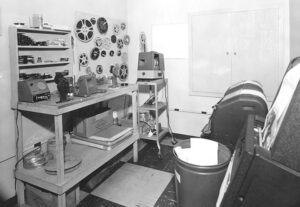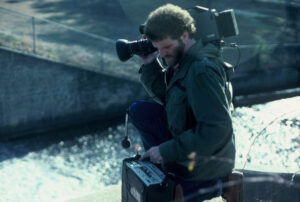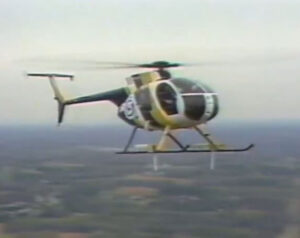
In the beginning there was film, the format that ruled the world of television news in the 1950s and 60s. It was news film that captured the Civil Rights movement, the Kennedy assassinations and the war in Vietnam. But in the mid-1970s, television news experienced an electronic revolution called ENG, or Electronic News Gathering. This is the story of news film and ENG and how WRAL-TV made the transition.
 Photographer Bob Sadler shooting with a Bell & Howell film camera.
Photographer Bob Sadler shooting with a Bell & Howell film camera.
WRAL-TV news photographers used 16 mm film cameras that were fairly lightweight. That asset alone enabled them to be nimble and quick out in the field. But getting the footage on the air was a laborious, tedious, time consuming process involving several steps.
First, there was the film run, with the term “run” referring to the film running through developing solution in the film processing machine. There was an as-needed run available mid-morning for film shot for the noon newscast. The first scheduled run was 1:00 PM. The second scheduled run, “the big one,” was 3:00 PM for the 6:00 o’clock newscast. A special run was available between 4-6 PM for film footage less than 100 feet.
News crews beat feet back to the station for the 3:00 PM deadline. There was no fudging that time; it was a “drop dead” deadline. Photographers would drop their film into a box located outside the dark room, and then knock on the door to alert the person assigned to processing.
There were three people in charge of film processing, which was akin to being a chemist; Billy Messer, Rich Raynor, and Jack Edwards. One of the three would be on duty. The film from each photographer’s camera would be unloaded from the canister, labeled, stapled to clear leader, and then attached one after another, creating a large reel. You can imagine the immense responsibility on the shoulders of these people; one screw-up would wipe out a full day of work with nothing to show during the newscast! Meanwhile, photographers were chomping at the bit to retrieve their processed film so they could start editing.
 The Houston Fearless color film processor.
The Houston Fearless color film processor.
The color film processor had the persona of a mythological beast. The name of the manufacturer, “Houston Fearless,” certainly put one on notice. It sucked down solution from seven tanks of film developing chemicals. Bearings, rollers, pumps ingested the film through various stages of development and then spewed it out the other end to the film dryer. The whole process took 30 minutes. Then, the person in charge of processing took down the big reel of film clips and separated them out and returned them to the photographers for editing, which was another laborious, time consuming step.
 Film edit work station
Film edit work station
The photographer’s edit-bench consisted of a supply reel of film that was fed through a viewer and splicing block, where the film was literally cut/spliced and then hot glued together, and then fed to the take-up reel. That finished piece was then added, according to the order in which it was scheduled to air during the newscast, to the “A” roll reel along with the other stories. The reel would finally make its way to the projection room where it was loaded onto a film projector.
 Projectionist Earll Thompson in the projection room.
Projectionist Earll Thompson in the projection room.
There were a myriad of things that could, and did occasionally go wrong, but you get the picture; film was a very linear, time consuming process…and expensive. Film could not be reused, and the Houston Fearless needed constant upkeep. Plus, there were only three people in the station who were schooled in the art of film development.
By 1975, television technology started to change and the hand-writing was on the wall. Portable, hand-held, electronic cameras using video-tube technology invaded television newsrooms. The old 16mm film era was coming to an end, replaced by portable video—or ENG.
 News photographer Jack Edwards using the Sony DXC1600P.
News photographer Jack Edwards using the Sony DXC1600P.
The first ENG camera used at WRAL was a Sony DXC1600P. Take a look at the picture of Jack Edwards wielding one in the picture. After consulting with Mike Upchurch, long time WRAL engineer, we believe the backpack that Jack is wearing probably holds the camera control unit (CCU), and batteries. The recorder was a VO-3800 and was very heavy. In fact, Mike said he does not recall seeing it used as a shoulder deck. He also added “…the camera produced terrible video. I was glad to see it go!”
Bob Sadler, retired WRAL photographer, recalled the primitive attempts at video editing before the arrival of ¾ inch editing controllers, and playback and record machines. “The first stories that I edited when WRAL bought its first video camera was me and Paul Pope standing in front of a quad machine in the basement. There was no way to synchronize edits on those machines so we figured out how long it took for my field recorder to get up to speed, say 3 sec. and Paul would back up the quad machine say 10 sec. and hit play and we would count down 10-9-8 (it was kind of like NASA launching the space shuttle) and at 3 seconds I would hit play on the field recorder and when we got to 0 Paul would hit the record button. Amazingly enough it worked, well most of the time.”
 News photographer Willis Boyd using the Ikegami HL-77 and separate recorder.
News photographer Willis Boyd using the Ikegami HL-77 and separate recorder.
The Ikegami HL-77 became the news camera of choice for WRAL. By-the-way, “HL” did not reference a high tech term; HL stood for “Handy-Looky” in Japanese. The camera weighed about twenty pounds. Fold in the weight of a bulky recorder and all the ancillary items, a photog could find him or herself schlepping a total of about 40 pounds of gear. The cost of the camera body alone was about $50,000. Add the necessary lens, batteries, recorder and other accessories, the price climbed higher. However, even with the cost of the camera, the economic edge went to the video camera. The tapes could be erased and used again.
The transition was underway, but it didn’t happen all at once at WRAL. For a period of time during the mid to late 70’s, a newscast was a hybrid of stories on film and ¾ inch tape. To distinguish between the two formats, the tape stories were referred to as ENG.
Electronic News Gathering not only referenced the camera technology, but also the technology that made news gathering mobile and live. Advancements in microwave equipment scaled down the size of antennas thereby paving the way for the “remote van” that was specifically designed for the purpose of news gathering. Granted, WRAL had a large special production truck with a huge microwave dish, but news needed a dedicated unit purposed specifically for a one or two person operation.
 “Action Cam 5” One of the first two ENG vans.
“Action Cam 5” One of the first two ENG vans.
In 1977, WRAL purchased two news remote vans “rack ready” from Wolf Coach. Legendary WRAL engineer, PB Jernigan, installed the equipment and wired everything together at the station. Each was equipped with mast antennas, often referred to as “golden rods” due to the two yellow-colored pitch fork looking prongs perched at the top of the mast. The mast was a hinged device that would unfold from its stored horizontal configuration on the roof of the van, to a vertical position for beaming back a microwave signal. The mast could be rotated around by the engineer technician, or “tech”, much like a sailor on a submarine would swing a periscope around. The first two techs were Bruce Wittman, who was assigned to Van 2, and Andy Hemmendinger, who was assigned to Van 3.
The microwave signal could be received by one of three different receiver dishes. One was located on the WRAL tall tower in Auburn, another on the CP&L building downtown, often, erroneously, referred to as the “omni,” and a third receiver located on the tower behind the station. Microwave is unique in that it is transmitted by line-of-sight. That is the main reason why the mast extends so precariously high atop the van. One very handy feature about the nature of microwave is its ability to “bounce,” or ricochet, off a building. Bruce Wittman recalled the times when he could not achieve a good angle on the mast to reach a particular receiver, but realized that he could reach it by aiming the antenna toward a building knowing the signal would bounce toward the receiver. Playing 8 ball on the pool table yields life applications!
 The 1st “Live” remote from an ENG van. WRAL Farm Reporter Verne Strickland interviewed NC STATE Chancellor Joab Thomas.
The 1st “Live” remote from an ENG van. WRAL Farm Reporter Verne Strickland interviewed NC STATE Chancellor Joab Thomas.
WRAL’s first ENG live shot took place at one of the N.C. State dairy research farms in Raleigh. In 1977, WRAL Farm Reporter Verne Strickland conducted an interview with Chancellor Joab Thomas. Strickland referred to the “remarkable new device” as ActionCam 5. Standing behind the photographer were Jim Goodmon and John Greene for the inaugural event. You can watch video of the first live shot on the CBC History Website.
 SKY 5 with the microwave antennas extended. Looks like two white sticks hanging from the skids.
SKY 5 with the microwave antennas extended. Looks like two white sticks hanging from the skids.
SKY 5 joined WRAL in the summer of 1979. Shortly after its arrival, microwave equipment made by Tayburn was installed onboard the helicopter. The early microwave unit was mounted on the skids of SKY 5. During flight, the antenna was stowed away in a configuration parallel to the skids. When it was time to “go live,” the pilot flipped a switch in the cockpit that lowered the rods, approximately two feet long, to a vertical position. A photographer sat in the front passenger seat and shot the action on the ground. The pilot had to remember to retract the antennas to the parallel configuration before landing!
In 1982, SKY 5 pilot Mike Allen worked with engineer PB Jernigan, devising a switcher and a camera mount that would allow the pilot to report live on camera and then switch to the second camera held by the photographer. This was a point of difference that set SKY 5 above the competition.
The consensus among WRAL alumnae who date back to the film days is that the transition to ENG was complete around 1981. The final hold-out was “The Tar Heel Traveler,” which was the last WRAL content shot on film.
Bob Sadler sums up the past forty years of film to video in a few short sentences. “The transition from film to video was painful, to say the least, but over time the video quality and camera technology got better and better. I grew to love video production, especially when it was in High Definition. Wow! I wonder what it will be like in another 40 years.”
We wonder too!
Thanks to Corp’s Pam Allen for this capcom story & these photos. Pam Parris Allen is a former WRAL newscast producer/director who now works as a researcher and producer on the CBC History Project.